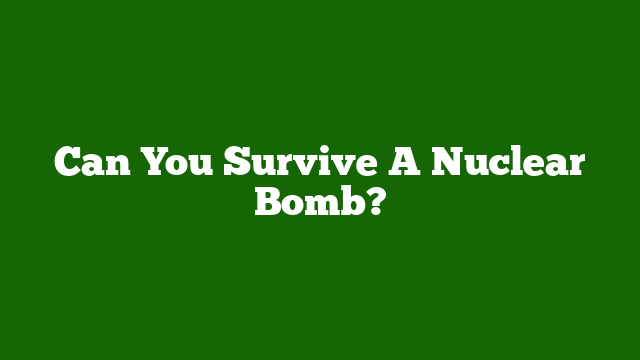Last Updated on June 12, 2023 by Umar
The threat of a nuclear bomb is a terrifying prospect, but can one actually survive such a catastrophic event?
This comprehensive blog post delves into personal stories, research, and statistics to provide a detailed analysis of survival possibilities in the face of a nuclear explosion.
Personal Stories
While there are no known personal accounts of individuals surviving a direct nuclear blast, there are stories of survival from the periphery of such events.
For example, during the bombings of Hiroshima and Nagasaki in 1945, some individuals managed to survive by taking shelter in reinforced structures or being shielded by natural barriers.
These stories, however, are rare and often involve a combination of luck and quick thinking.
Research on Nuclear Bomb Survival
Research on nuclear bomb survival has been conducted for decades, with various factors influencing the likelihood of survival.
Some key factors include:
- Distance from Ground Zero: The closer one is to the epicenter of the blast, the lower the chances of survival. At a certain distance, the heat, pressure, and radiation levels become unsurvivable.
- Shelter: Taking shelter in a reinforced structure, such as a concrete building or underground bunker, can significantly increase the chances of survival. However, the effectiveness of the shelter depends on its distance from the blast and its ability to withstand the pressure and heat generated by the explosion.
- Radiation Exposure: Surviving the initial blast is only part of the challenge. Prolonged exposure to radiation can lead to acute radiation sickness and long-term health issues, such as cancer. Reducing exposure to radioactive fallout is crucial for survival.
Statistics on Nuclear Bomb Survival
Statistical data on nuclear bomb survival is limited, as there have been only two instances of nuclear weapons being used in warfare (Hiroshima and Nagasaki).
However, studies and simulations have been conducted to estimate the potential casualties and survival rates in the event of a nuclear attack.One such study, conducted by the RAND Corporation, estimated that a 10-kiloton nuclear explosion in a densely populated urban area could result in approximately 100,000 fatalities and 250,000 injuries.
The study also found that taking shelter in a basement or a central room of a multi-story building could increase the chances of survival by up to 50%.
Conclusion
Surviving a nuclear bomb is not impossible, but the odds are heavily stacked against those caught in the blast zone.
Distance, shelter, and minimizing radiation exposure are critical factors in increasing the chances of survival.
While personal stories of survival are scarce, research and statistics provide valuable insights into the potential consequences of a nuclear explosion and the steps one can take to improve their chances of survival.

